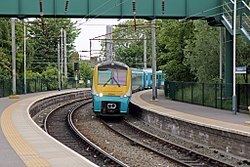Status Open Owner Network Rail | Termini Chester | |
 | ||
Other name(s) Chester to Manchester Line (via Warrington Bank Quay) Locale Greater Manchester
Cheshire
Chester
North West England Operator(s) Northern Rail and Arriva Trains Wales Track gauge 1,435 mm (4 ft 8 ⁄2 in) standard gauge Rolling stocks British Rail Class 67, British Rail Class 142, British Rail Class 150, British Rail Class 156, British Rail Class 175 | ||
The Chester–Manchester line is one of two lines which run between the cities of Chester and Manchester in North West England. It is the faster of the two lines, and runs via Warrington Bank Quay. The other (slower) line is the Mid-Cheshire line.
Contents
There is currently one train per hour in each direction from Chester to Manchester, but from December 2017 there will be an additional train per hour in each direction, calling only at Chester, Warrington Bank Quay and Manchester Victoria.
Description
Both routes to Manchester share the Chester to Crewe line for a short distance to Brook Lane Junction where the Manchester lines diverge to Mickle Trafford at which point the southern route of the Cheshire Lines Committee (see the Mid-Cheshire Line) diverges south-easterly to Mouldsworth whilst the considerably older route built by the London and North Western Railway continues to Helsby (junction from Ellesmere Port), Frodsham (nearest station to the junction for the Halton Curve), Runcorn East . Then through the Sutton Tunnel (over a mile long) and northwards alongside the West Coast Main Line into Warrington Bank Quay railway station.
From Warrington the route follows the original Grand Junction Railway route northwards through Winwick Junction to Earlestown where it joins George Stephenson's original Liverpool and Manchester Railway, which was the world's first inter-city railway, having opened in 1830. From here this venerable route is via Newton-le-Willows, Patricroft and Eccles and then either via the earlier route to Manchester Victoria station or, as at present, via Ordsall Lane and Castlefield junctions, joining the Manchester–Preston line and on to Deansgate, Manchester Oxford Road and Manchester Piccadilly station at platforms 13 & 14.
Services
Arriva Trains Wales operate an hourly service throughout between Manchester and Chester (no trains stop at Patricroft, Eccles or Deansgate, with 1 train per day from Holyhead not calling at Newton-le-Willows or Manchester Oxford Road.) which are served by Liverpool to Manchester lines) and onwards calling at all stations to Llandudno on the North Wales Coast Line (except Sundays, when trains terminate at Chester).
Class 175 units are primarily used for the services between Manchester and North Wales, although Class 158 units can appear; Class 142 Pacer and Class 156 Sprinter units are used on the infrequent service between Liverpool/Warrington B.Q and Ellesmere Port which share the line between Warrington and Helsby.
It is also used by the Freightliner Group for access to the rail-served maritime freight terminal at Ellesmere Port.
